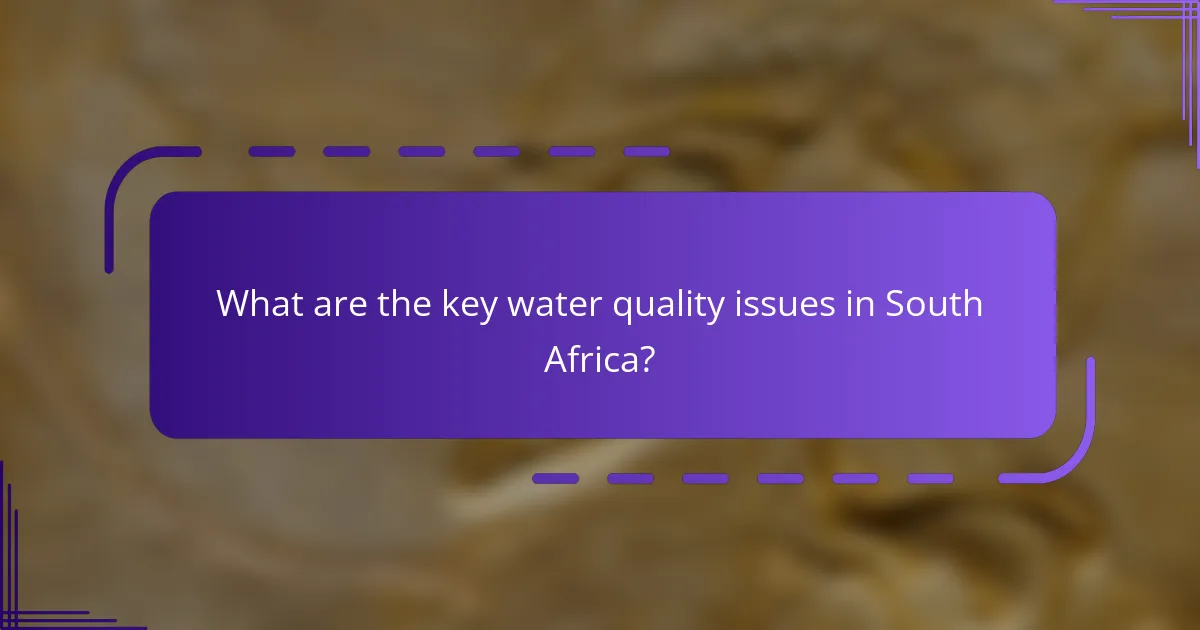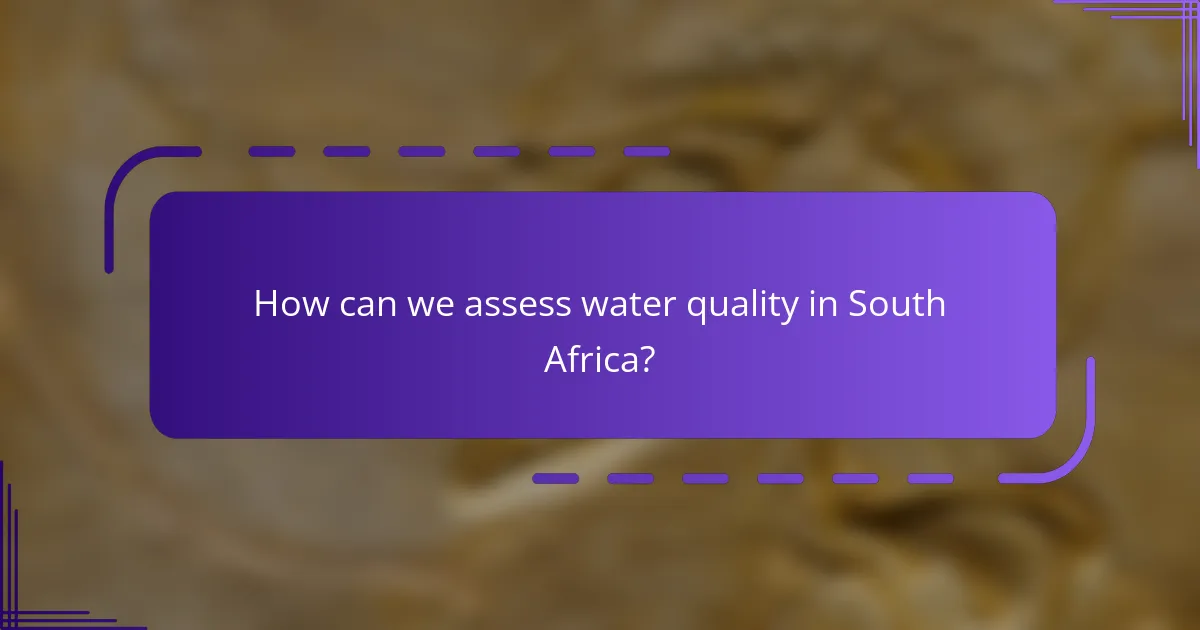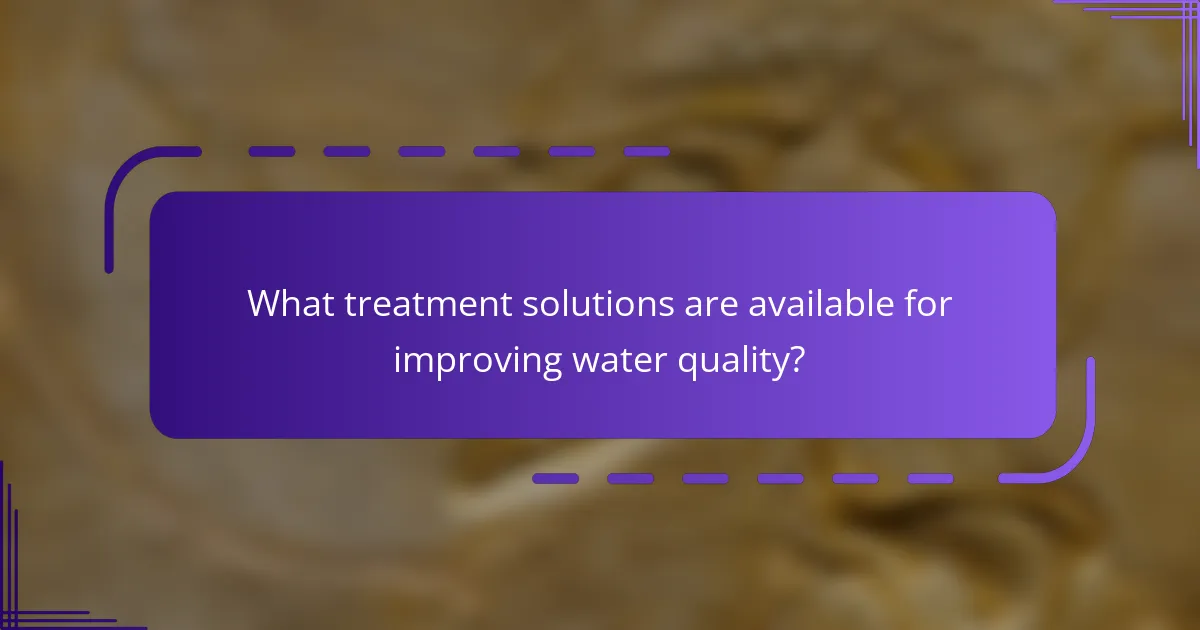Water quality in South Africa is significantly impacted by contamination from pollutants, inadequate sanitation, and water scarcity. Key pollutants include heavy metals, pathogens, and agricultural runoff, which compromise the safety of water sources and contribute to the prevalence of waterborne diseases. Regular assessment methods, including physical, chemical, and biological testing, reveal that many water sources are contaminated, necessitating ongoing monitoring and improvement efforts. Treatment solutions such as filtration, chemical disinfection, and biological treatment are essential for enhancing water quality and ensuring public health and environmental sustainability. Addressing these critical issues is vital for improving access to safe water across communities in South Africa.

What are the key water quality issues in South Africa?
Key water quality issues in South Africa include contamination from pollutants, inadequate sanitation, and water scarcity. Pollutants such as heavy metals, pathogens, and agricultural runoff compromise water safety. Inadequate sanitation facilities contribute to the spread of waterborne diseases. The World Health Organization reported that waterborne diseases are a significant health risk in the region. Water scarcity exacerbates these issues, affecting access to clean water. The Department of Water and Sanitation highlights that many communities rely on unsafe water sources. Additionally, industrial discharge often leads to localized pollution in rivers and lakes. Addressing these issues is crucial for public health and environmental sustainability.
What contaminants affect water quality in South Africa?
Contaminants affecting water quality in South Africa include heavy metals, pathogens, and agricultural runoff. Heavy metals such as lead, mercury, and cadmium can leach into water supplies from mining and industrial activities. Pathogens, including bacteria and viruses, often enter water sources through inadequate sanitation and sewage systems. Agricultural runoff introduces pesticides and fertilizers, contributing to nutrient pollution and harmful algal blooms. Studies indicate that these contaminants pose significant health risks, leading to waterborne diseases and other health issues. For example, the World Health Organization reports that contaminated water can cause cholera and dysentery outbreaks.
How do heavy metals impact water sources?
Heavy metals significantly contaminate water sources. They can enter water systems through industrial discharge, mining, and agricultural runoff. Common heavy metals include lead, mercury, and cadmium. These metals are toxic to aquatic life and can bioaccumulate in organisms. High concentrations can lead to ecosystem imbalances. Human consumption of contaminated water poses health risks, including neurological damage and cancer. Studies indicate that even low levels of heavy metals can affect water quality. For example, the World Health Organization sets strict limits on heavy metal concentrations in drinking water to protect public health.
What role do agricultural runoff and pesticides play in contamination?
Agricultural runoff and pesticides significantly contribute to water contamination. Runoff occurs when rainwater washes away fertilizers, pesticides, and other chemicals from fields into nearby water bodies. This process introduces harmful substances into rivers, lakes, and groundwater. Pesticides, designed to kill pests, can be toxic to aquatic life and may disrupt ecosystems.
In South Africa, studies show that agricultural practices are a major source of water pollution. For instance, the Department of Water and Sanitation reported high levels of nitrates and phosphates in water sources linked to agricultural runoff. These contaminants can lead to health risks for humans and wildlife. Contaminated water can cause diseases and disrupt drinking water supplies.
Overall, the role of agricultural runoff and pesticides in contamination is critical and poses significant threats to water quality and public health.
How does industrial waste contribute to water quality issues?
Industrial waste significantly contributes to water quality issues by introducing harmful pollutants into water bodies. These pollutants can include heavy metals, chemicals, and organic waste. When industrial waste is improperly disposed of, it can leach into groundwater or flow into rivers and lakes. This contamination can lead to toxic levels of substances like lead and mercury in the water. According to the South African Department of Water and Sanitation, industrial discharges are a primary source of water pollution. The presence of these contaminants can harm aquatic life and disrupt ecosystems. Additionally, polluted water can pose serious health risks to human populations relying on these water sources for drinking and agricultural use.
What are the primary health risks associated with poor water quality?
The primary health risks associated with poor water quality include gastrointestinal diseases, cholera, and dysentery. Contaminated water can harbor pathogens such as bacteria, viruses, and parasites. These pathogens can cause severe illness upon ingestion. For instance, cholera can lead to dehydration and death if untreated. According to the World Health Organization, 2.2 million people die annually from diarrheal diseases linked to unsafe drinking water. Additionally, long-term exposure to contaminated water may result in chronic health issues such as kidney damage and reproductive problems. In South Africa, specific contaminants like E. coli and heavy metals further exacerbate these health risks.
How can contaminated water lead to diseases?
Contaminated water can lead to diseases by introducing pathogens and harmful chemicals into the body. These contaminants can include bacteria, viruses, parasites, and toxic substances. When ingested, these pathogens can cause gastrointestinal diseases, cholera, and dysentery. Chemical contaminants can lead to long-term health issues, such as cancer or organ damage. According to the World Health Organization, unsafe drinking water is a major cause of diarrheal diseases, which kill an estimated 485,000 children each year. In South Africa, poor water quality due to pollution and inadequate sanitation exacerbates health risks. Contaminated water affects vulnerable populations disproportionately, leading to higher disease prevalence in these communities.
What vulnerable populations are most affected by water-related health risks?
Children, the elderly, and low-income communities are the most affected vulnerable populations by water-related health risks. Children are particularly susceptible due to their developing immune systems. The elderly often have pre-existing health conditions that can be exacerbated by contaminated water. Low-income communities frequently lack access to safe drinking water and sanitation facilities. According to the World Health Organization, these groups face higher rates of waterborne diseases. In South Africa, disparities in water quality access highlight the risks for these populations. Studies show that marginalized communities experience significant health impacts due to inadequate water infrastructure.
Why are children and the elderly at higher risk?
Children and the elderly are at higher risk due to their vulnerable immune systems. Children have developing immune responses, making them more susceptible to infections. The elderly often have weakened immune systems and existing health conditions. Both groups can experience severe health effects from waterborne contaminants. For example, children may suffer from developmental issues. The elderly may face complications from diseases like cholera or dysentery. Research indicates that these populations are more likely to experience severe dehydration and mortality from water-related illnesses. In South Africa, contaminated water sources exacerbate these risks, highlighting the need for improved water quality.

How can we assess water quality in South Africa?
Water quality in South Africa can be assessed through various methods. These methods include physical, chemical, and biological testing. Physical testing evaluates parameters like turbidity and temperature. Chemical testing measures pollutants such as heavy metals and nutrients. Biological testing examines the presence of microorganisms. Regular monitoring is essential for accurate assessment. The Department of Water and Sanitation oversees water quality standards. According to the 2021 National Water Quality Report, many water sources are contaminated. This highlights the need for ongoing evaluation and improvement efforts.
What methods are used for testing water quality?
Common methods for testing water quality include physical, chemical, and biological analyses. Physical tests assess parameters like turbidity and temperature. Chemical tests measure pH, dissolved oxygen, and contaminants such as heavy metals. Biological tests evaluate the presence of microorganisms like bacteria and viruses. Each method provides crucial data on water safety and suitability for consumption. For instance, the presence of E. coli in a sample indicates fecal contamination, posing health risks. Regular testing is essential for maintaining safe drinking water standards.
What are the common indicators of water quality?
Common indicators of water quality include pH level, turbidity, dissolved oxygen, and microbial content. The pH level indicates acidity or alkalinity, typically ranging from 6.5 to 8.5 for safe drinking water. Turbidity measures water clarity, with higher levels suggesting contamination. Dissolved oxygen is crucial for aquatic life; levels below 5 mg/L can be harmful. Microbial content, including coliform bacteria, signifies potential health risks. These indicators are essential for assessing water safety and environmental health.
How do laboratory tests differ from field tests?
Laboratory tests differ from field tests primarily in their environment and methodology. Laboratory tests are conducted in controlled settings, ensuring precise conditions for accurate measurements. These tests analyze water samples under standardized protocols, often using advanced equipment. Field tests occur in the water source’s natural environment, allowing for immediate results. They typically use portable kits to measure specific parameters on-site.
Laboratory tests can detect a wider range of contaminants due to sophisticated technology. They also provide more detailed data, such as concentration levels of various pollutants. Field tests, while quicker, may not capture all relevant data due to equipment limitations. Each method serves different purposes in assessing water quality.
What regulations govern water quality in South Africa?
The regulations governing water quality in South Africa include the National Water Act of 1998 and the Water Services Act of 1997. The National Water Act establishes the framework for water resource management. It aims to ensure sustainable use and protection of water resources. The Water Services Act focuses on the provision of water services to communities. It sets standards for water quality and access. Additionally, the Department of Water and Sanitation enforces these regulations. Compliance is monitored through regular assessments and reporting. These laws aim to safeguard public health and the environment.
What are the key laws and standards in place?
The key laws and standards in place for water quality in South Africa include the National Water Act and the Water Services Act. The National Water Act of 1998 governs water resource management and establishes a framework for sustainable use. It aims to ensure equitable access to water and protect water quality. The Water Services Act of 1997 focuses on the provision of water services to communities. It mandates the delivery of safe and reliable water supply and sanitation services. Additionally, the South African Bureau of Standards (SABS) sets specific water quality standards. These standards guide the monitoring and assessment of water quality across the country. Compliance with these laws and standards is critical for public health and environmental protection.
How is compliance monitored and enforced?
Compliance with water quality standards in South Africa is monitored through regular assessments and inspections by regulatory bodies. The Department of Water and Sanitation oversees compliance with the National Water Act. Water quality testing is conducted at various points, including treatment facilities and distribution systems. Monitoring includes checking for contaminants such as bacteria, heavy metals, and chemical pollutants. Enforcement actions can include fines, penalties, and legal actions against non-compliant entities. The National Water Quality Monitoring Programme provides data to support compliance efforts. Regular reporting and public access to water quality data enhance transparency and accountability.

What treatment solutions are available for improving water quality?
Treatment solutions for improving water quality include filtration, chemical disinfection, and biological treatment. Filtration removes physical impurities and sediments from water. Common filtration methods are sand filters and membrane filters. Chemical disinfection involves adding substances like chlorine or ozone to eliminate pathogens. This method is widely used in municipal water treatment facilities. Biological treatment utilizes microorganisms to break down organic matter. This process is effective in wastewater treatment plants. Advanced oxidation processes can also degrade contaminants and improve water quality. Each of these methods can significantly enhance the safety and usability of water resources.
What are the common water treatment methods used in South Africa?
Common water treatment methods used in South Africa include coagulation, sedimentation, filtration, and disinfection. Coagulation involves adding chemicals to water to form clumps of particles. These clumps, called flocs, then settle to the bottom during sedimentation. Filtration removes remaining particles through various media, such as sand or activated carbon. Disinfection, often using chlorine or UV light, kills harmful microorganisms. According to the Department of Water and Sanitation, these methods are essential for ensuring safe drinking water in the country.
How do filtration systems work to remove contaminants?
Filtration systems work by physically removing contaminants from water. They utilize various mechanisms such as adsorption, straining, and chemical reactions. In adsorption, contaminants adhere to the surface of filter media, effectively trapping them. Straining involves the physical blocking of particles larger than the filter’s pore size. Chemical reactions can neutralize or precipitate contaminants, making them easier to remove.
Common filter media include activated carbon, sand, and membrane filters. Activated carbon is especially effective for organic compounds and chlorine. Sand filters are often used for larger particles and turbidity. Membrane filters can remove bacteria and viruses due to their tiny pore sizes.
Research indicates that properly maintained filtration systems can significantly improve water quality. For example, a study published in the Journal of Water Supply Research and Technology found that household filtration systems reduced contaminants by up to 99%. This highlights the effectiveness of filtration in ensuring safe drinking water.
What is the role of chemical treatments in water purification?
Chemical treatments play a crucial role in water purification by removing contaminants and ensuring safe drinking water. These treatments involve the addition of chemicals to water to eliminate harmful substances. Common chemicals used include chlorine, which disinfects by killing bacteria and viruses. Coagulants like aluminum sulfate help to aggregate particles, making them easier to remove. Flocculants assist in settling out impurities from water. Chemical treatments also adjust pH levels, which can enhance the effectiveness of disinfection. According to the World Health Organization, proper chemical treatment is essential for reducing health risks associated with contaminated water. Effective chemical treatments can significantly improve water quality and public health outcomes.
How can communities implement sustainable water solutions?
Communities can implement sustainable water solutions by adopting rainwater harvesting systems. These systems collect and store rainwater for various uses, reducing reliance on municipal supplies. Additionally, communities can promote water-efficient practices such as xeriscaping and using low-flow fixtures. Education on water conservation is crucial for encouraging responsible usage among residents. Implementing greywater recycling systems can also enhance sustainability by reusing water from sinks and showers. Collaborating with local governments and NGOs can provide resources and expertise for these initiatives. Evidence shows that communities practicing these methods can significantly reduce water scarcity and improve overall water quality.
What are the benefits of rainwater harvesting?
Rainwater harvesting provides multiple benefits, particularly in areas facing water scarcity. It reduces dependence on municipal water supplies. This method captures and stores rainwater for various uses. It can significantly decrease water bills for households and businesses. Rainwater harvesting also helps in flood control by reducing surface runoff. It enhances groundwater recharge, which is crucial for maintaining local aquifers. Additionally, harvested rainwater is often of high quality, free from many contaminants found in surface water. Implementing rainwater harvesting can lead to sustainable water management practices in regions like South Africa.
How can education and awareness improve water quality management?
Education and awareness can significantly improve water quality management by informing communities about best practices. Increased knowledge leads to better decision-making regarding water usage and conservation. Awareness campaigns can educate the public on the health risks associated with contaminated water. For instance, understanding the effects of pollutants can motivate individuals to advocate for cleaner water sources. Training programs for local authorities can enhance their ability to monitor and manage water quality effectively. Research indicates that communities engaged in educational initiatives show improved water management outcomes. According to the World Health Organization, education is crucial for promoting safe water practices and reducing health risks.
What practical steps can individuals take to ensure safe drinking water?
Individuals can ensure safe drinking water by employing several practical steps. First, they should use water filters certified to remove contaminants. Filters can eliminate bacteria, viruses, and heavy metals. Regularly maintaining and replacing filters is essential for effectiveness. Second, boiling water for at least one minute can kill pathogens. Boiling is a reliable method, especially in emergencies. Third, individuals should test their water quality periodically. Testing kits can identify contaminants like lead and nitrates. Fourth, storing water in clean, food-grade containers prevents recontamination. Finally, individuals should stay informed about local water quality reports. Awareness of any advisories can guide safe practices.
Water quality issues in South Africa are critically impacted by contaminants such as heavy metals, pathogens, and agricultural runoff, leading to significant health risks including gastrointestinal diseases and cholera. The article details the sources of these pollutants, including industrial waste and inadequate sanitation, and highlights vulnerable populations most affected by water-related health risks. It also discusses various methods for assessing and treating water quality, emphasizing the importance of sustainable solutions like rainwater harvesting and community education in improving public health outcomes.